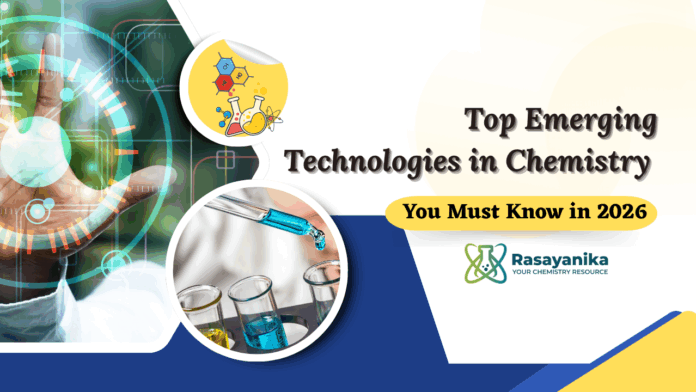Table of Contents
Top 10 Emerging Technologies in Chemistry You Must Know in 2026
Chemistry is one of the most transforming research areas in science. And from designing new materials to combating global challenges such as climate change, chemists not only help build these innovative technologies but also are known to define the future of the next generation.
As we step into 2026, the Top 10 Emerging Technologies in Chemistry identified by the International Union of Pure and Applied Chemistry (IUPAC, 2025) highlight how the field blends creativity, computation, and sustainability. This article simplifies these groundbreaking ideas for enthusiasts like you as well as for research scholars to grasp their impact and get inspired to work in these areas themselves.
1. Additive Manufacturing for Chemical Labs
As technology advances rapidly, 3D bioprinting is gaining further momentum. This is also one of the top emerging technologies in chemistry . Generally known as additive manufacturing. Here, we can observe that the techniques used for printing are not just limited to plastics or just engineering parts. Now, researchers can successfully design “reactionware”. They are beneficial for customizing reactions and enabling precise experiments.
This is one of the beneficial emerging technologies, as this can help in reducing the costs required for manufacturing medicines, helping in faster designing of prototypes, as well as building miniature chemical plants. In the future, it can also be seen that the designing part can be way easier, like drawing 3D models.
2. Single-Atom Catalysis
The word catalysis immediately strikes that it is altering the rate of a reaction in chemical processes. In industries, catalysts play an important role in speeding up th chemical reaction, thereby helping in faster manufacturing processes. And technologies such as single-atom catalysis take this to one higher level. Instead of using clusters of metals, researchers can now attach single metal atoms onto supports, creating precise, efficient, and sustainable catalysts.
This is highly beneficial in reducing the need for expensive catalysts such as platinum. It drastically heps in cutting down the expenses. Researchers who are working on emerging trends in chemistry can use these single-atom catalysts. This also oprns opens new routes for clean energy, green manufacturing, and waste-free synthesis.
3. Direct Air Capture and Electrochemical CO₂ Conversion
One of the major challenges th whole world is trying to combat is global warming and reducing pollutants. Hence, carbon capture technology stays at the top of emerging technologies in chemistry. In this technology, we can observe how Direct Air Capture (DAC) removes CO₂ straight from the air, while electrochemical processes convert it into fuels or valuable chemicals.
In 2025, researchers improved sorbent materials and developed electrochemical cells that use renewable electricity to turn CO₂ into methanol and other feedstocks. These methods show how chemistry can actively reverse emissions, turning pollutants into products.
4. Thermogelling Polymers
Imagine a liquid that turns into a gel when it’s warmed; that’s what thermogelling polymers do. These innovative materials respond to temperature changes, enabling drug delivery systems that release medicines exactly when and where needed.
In tissue engineering and medical devices, they are revolutionizing how we deliver therapies. Incorporating chemistry technologies such as polymer synthesis, supramolecular design, and functional performance, thermogelling systems are key to future materials landscapes.
5. Multimodal Foundation Models for Structure Elucidation
Determining molecular structures traditionally takes days of spectroscopy and analysis. But new AI in chemistry systems combine data from NMR, MS, and X-ray crystallography to predict structures in minutes.
These multimodal foundation models, like the AI models revolutionizing language and images, are now doing the same for chemistry. For research scholars, this marks the start of a digital revolution in structural chemistry, where machines learn from massive datasets and help chemists interpret results faster and more accurately.
6. Synthetic Cells
If researchers could build life from scratch, it would pave the way for numerous innovations in the coming years. Synthetic cells aim to precisely make this possible.
It deals with creating minimal, artificial cells that mimic biological ones using only chemical components. These systems help scientists understand how life works and may lead to programmable “chemical factories” that produce medicines, fuels, or materials inside tiny cell-like structures.
7. Carbon Dots
Carbon dots are nanometer-sized particles that glow under light, making them useful in sensors, imaging, and optoelectronic devices. What makes them revolutionary is their eco-friendly synthesis; they can even be made from biomass waste.
Researchers are using carbon dots for detecting pollutants, drug delivery, and bioimaging. Their tunable optical properties make them a sustainable alternative to toxic quantum dots.
8. Nanochain Biosensors
Nanochain biosensors are ultra-sensitive detection systems. They are designed to use nanoscale chains of metals or polymers to sense biological molecules or chemicals. Their unique structure enhances conductivity and signal strength, allowing for faster and more accurate diagnostics.
This technology could soon be used in wearable health devices, environmental monitoring, or food safety testing. For students and scholars, nanochain sensors highlight how chemistry connects to electronics, biology, and data science.
9. Xolography
Among the latest breakthroughs in manufacturing is xolography — a volumetric 3D printing technique that creates high-resolution polymer structures in seconds. Unlike layer-by-layer printing, xolography uses intersecting light beams to solidify an entire shape at once.
This allows the creation of intricate microstructures useful in drug delivery, optics, and materials science. For researchers exploring 3D bioprinting, xolography provides a major leap in precision and speed.
10. Polymer Upcycling and Circular Chemistry
While not on every list, many experts highlight polymer upcycling as a new frontier closely tied to 2026’s Top 10 Emerging Technologies in Chemistry. Researchers are designing catalysts and chemical routes that break down plastic waste into valuable chemicals, closing the loop of plastic use.
This area connects sustainable chemistry, catalysis, and engineering, representing a practical step toward a circular economy. For young chemists, it’s a reminder that chemistry’s next big mission is planetary sustainability.
Why These Technologies Matter
The Top 10 Emerging Technologies in Chemistry redefine what chemists do:
- They solve global challenges like carbon capture, waste reduction, and drug delivery.
- They merge disciplines: AI, materials science, biology, and computation.
- They encourage innovation that benefits both industry and the environment.
For students, learning about these new trends in chemistry means staying ahead of what future labs and careers will look like. For research scholars, these technologies point to areas with strong funding, collaboration, and publication potential.
Chemistry’s future is not only about discovering new molecules — it’s about designing smarter systems and sustainable processes. As these technologies mature, they will reshape everything from pharmaceuticals to environmental engineering.
Students today will be the next-generation chemists leading this transformation — designing synthetic cells, developing AI tools for molecule prediction, and capturing carbon from the air.
Bonus Section: Quantum Chemistry- The Future of Molecular Understanding
Quantum chemistry is becoming one of the most exciting frontiers in science. Instead of using traditional computers to model molecules, this field uses quantum computers, which can understand the tiny, complex behaviors of electrons much more accurately. This means chemists can now predict how molecules react, how catalysts work, or how new drugs might behave, all before running a single experiment in the lab.
By 2026, quantum chemistry is expected to play a significant role in the design of cleaner fuels, more innovative materials, and faster drug-discovery pipelines. Many Tech leaders have already created early quantum platforms capable of simulating small but complex molecules, giving researchers a level of precision that was impossible just a few years ago.
For students and young researchers, this is a field full of opportunity. Quantum chemistry blends physics, computation, and chemistry into a powerful discipline, opening the door to breakthroughs that could reshape the future of science.
Key Takeaways from Top 10 Emerging Technologies in Chemistry:
- AI-powered chemistry is making molecular design faster and more predictive.
- Carbon capture technology is helping reduce greenhouse emissions while creating valuable products.
- Quantum computing offers unmatched precision for molecular simulations.
- Sustainable polymers and molecular recycling are driving a waste-free future.
- 3D bioprinting and Xolography are redefining materials engineering.
- Electrochemical systems are accelerating clean energy storage innovations.
- Smart sensors and nanotech are integrating chemistry into daily life applications.
Together, these breakthroughs represent a future where chemistry becomes more intelligent, interconnected, and sustainable, shaping how the world innovates in 2026 and beyond.















































